初中英语基础知识(知识点)合集
初中英语完整知识点总结
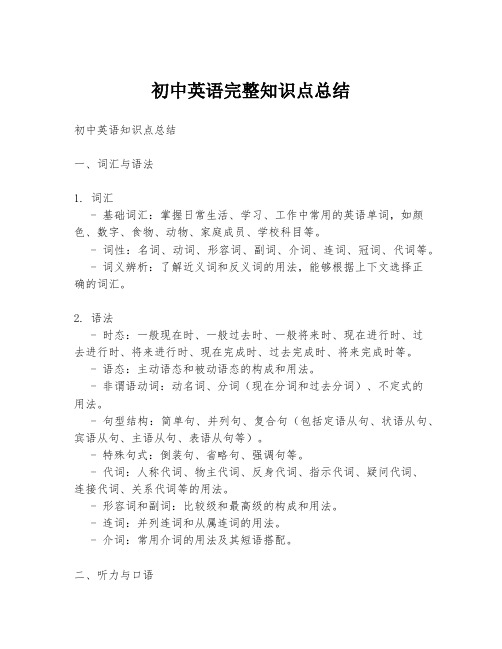
初中英语完整知识点总结初中英语知识点总结一、词汇与语法1. 词汇- 基础词汇:掌握日常生活、学习、工作中常用的英语单词,如颜色、数字、食物、动物、家庭成员、学校科目等。
- 词性:名词、动词、形容词、副词、介词、连词、冠词、代词等。
- 词义辨析:了解近义词和反义词的用法,能够根据上下文选择正确的词汇。
2. 语法- 时态:一般现在时、一般过去时、一般将来时、现在进行时、过去进行时、将来进行时、现在完成时、过去完成时、将来完成时等。
- 语态:主动语态和被动语态的构成和用法。
- 非谓语动词:动名词、分词(现在分词和过去分词)、不定式的用法。
- 句型结构:简单句、并列句、复合句(包括定语从句、状语从句、宾语从句、主语从句、表语从句等)。
- 特殊句式:倒装句、省略句、强调句等。
- 代词:人称代词、物主代词、反身代词、指示代词、疑问代词、连接代词、关系代词等的用法。
- 形容词和副词:比较级和最高级的构成和用法。
- 连词:并列连词和从属连词的用法。
- 介词:常用介词的用法及其短语搭配。
二、听力与口语1. 听力- 听力理解:能够理解日常对话、短文、通知、广告等不同场景的英语听力材料。
- 听力技巧:学会通过上下文、关键词、语调等线索来提高理解能力。
- 听力练习:定期进行听力练习,提高对不同口音、语速的适应能力。
2. 口语- 发音:掌握正确的英语发音规则,包括元音、辅音、连读、失去爆破等。
- 口语表达:能够用英语进行自我介绍、日常交流、描述事物、表达观点等。
- 情景对话:熟悉各种生活、学习、工作中的常见对话场景,并能够进行模拟练习。
- 口语练习:通过角色扮演、小组讨论、演讲等活动提高口语流利度和准确性。
三、阅读与写作1. 阅读- 阅读理解:能够理解不同类型的阅读材料,如故事、科普文章、广告、说明文等。
- 阅读技巧:学会使用略读、查读、精读等策略来提高阅读效率。
- 阅读练习:定期进行阅读练习,拓宽词汇量,提高理解和分析能力。
【中考复习资料】初中英语复习知识点汇总
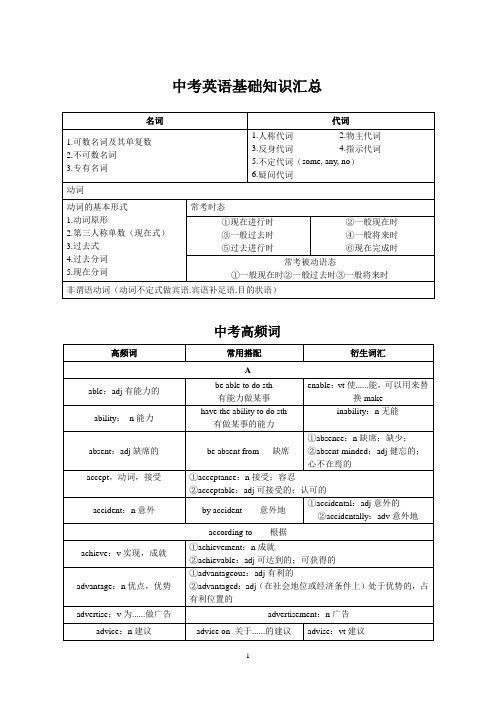
②Knock sb∕sth into a cocked hat
远远胜过某人(或事物);大大超过;是相形见绌
L
lead:引导;指引;领导;名词,铅
lead to导致;通向
leader:n领袖
leadership:n领导力
leave:vi离开
leave for去往,使某人或某物处于某种状态
date:vt约会;n日期
date sb,约会某人
depen:vi依靠,依赖
depend on依赖,取决于
①dependent:adj依靠的,依赖的②dependence:n依赖,依存,瘾,相关(性),依存(关系)③independent:adj独立的
describe:vt描述
①description:n描述
C
calendar:n日历
cancel:vt取消
capital:n首都,资本,大写字母;adj死刑的,大写的,极好的
comfortable:adj舒服的
be comfortable with自在的
①uncomfortable:adj不舒服的②comfort:n舒服;vt安慰
culture:n文化
cultural:adj文化的
⑤过去进行时
②一般现在时
④一般将来时
⑥现在完成时
常考被动语态
①一般现在时②一般过去时③一般将来时
非谓语动词(动词不定式做宾语.宾语补足语.目的状语)
中考高频词
高频词
常用搭配
衍生词汇
A
able:adj有能力的
be able to do sth
有能力做某事
enable:vt使......能,可以用来替换make
初中英语基础知识(全)
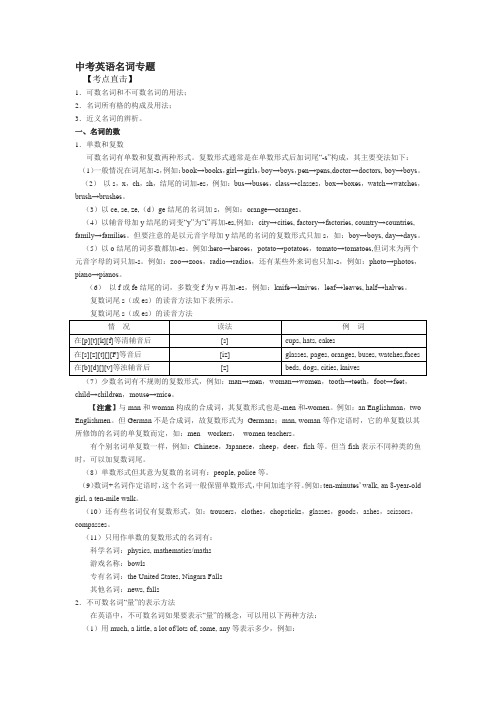
yourself 你
yourselves 你 们
自己
自己
himself 他自己
自己
他们
herself 她
themselves 她
自己
们自己
itself 它
它们
自己
自己
2、反身代词常用于一些固定搭配中。如:
teach oneself 自学
learn by oneself 自学
enjoy oneself 过得愉快,玩得高兴 help oneself to 随便吃
Who is your uncle?
--- This is my dictionary. Where is________ ? (you r , yours )
----It’s over there, on the bed.
---Tom, is this your pen? ---Yes, it’s ______. (yours, his, mine, my)
★ (4) 名词词性物主代词可用在 of 后面作定语,相当于“of+名词所有格”,表示带有部分概念或有一定的感
情色彩。如: He is a friend of mine.
二. 反身代词
1、反身代词的单复数形式列表如下:
人
称
单
复数
数
数
第一人称
myself 己
我自
ourselves
自己
我们
第二人称 第三人称
child→children,mouse→mice。
【注意】与 man 和 woman 构成的合成词,其复数形式也是-men 和-women。例如:an Englishman,two
Englishmen。但 German 不是合成词,故复数形式为 Germans;man, woman 等作定语时,它的单复数以其
初中英语知识点归纳总结.pdf

初中英语知识点归纳总结.pdf一、词汇与短语1. 基础词汇- 常见名词:家庭成员、学校科目、日常用品、颜色、数字、食物等。
- 常见动词:行为动词(如:run, eat, study)、be动词、情态动词(如:can, must, should)。
- 常见形容词:描述人物特征(如:tall, short, kind)、物品特征(如:big, small, new)。
- 常见副词:时间副词(如:yesterday, tomorrow)、频率副词(如:often, usually, never)。
2. 短语搭配- 动词短语:look at, listen to, talk about, play with等。
- 介词短语:in the morning, on the desk, under the bed等。
- 常用表达:How are you? I’m fine, thanks. / What’s your name? My name is... / Can I help you? / Sorry, I don’t know.二、语法知识1. 时态- 一般现在时:表示经常性或习惯性的动作,如:I usually get up at 6:30.- 一般过去时:表示过去某一确定时间发生的动作,如:He visited his grandparents last weekend.- 一般将来时:表示将来某一时间会发生的动作,如:They will go on a trip next month.- 现在进行时:表示正在进行的动作,如:She is reading a book now.2. 句型结构- 陈述句:用来陈述事实或观点,如:The Earth revolvesaround the Sun.- 疑问句:用来提出问题,如:Do you like apples? / Where is your school?- 否定句:用来表示否定意义,如:He doesn’t like milk.3. 代词- 人称代词:主格(I, you, he, she, it, we, they)和宾格(me, you, him, her, it, us, them)。
初中英语基础知识大全

初中英语基础知识⼤全 初中英语是单词和语法的综合,想要学好英语就要勤背单词,梳理清楚每个语法知识。
下⾯是⼩编为⼤家整理的关于初中英语基础知识⼤全,希望对您有所帮助。
欢迎⼤家阅读参考学习! 初中英语基础知识 1 (see 、hear 、notice 、find 、feel 、listen to 、 look at (感官动词)+ do eg :I like watching monkeys jump 2 (⽐较级 and ⽐较级) 表⽰越来越怎么样 3 a piece of cake =easy ⼩菜⼀碟(容易) 4 agree with sb 赞成某⼈ 5 all kinds of 各种各样 a kind of ⼀样 6 all over the world = the whole world 整个世界 7 along with 同……⼀道,伴随…… eg : I will go along with you 我将和你⼀起去 the students planted trees along with their teachers 学⽣同⽼师们⼀起种树 8 As soon as ⼀怎么样就怎么样 9 as you can see 你是知道的 10 ask for ……求助向…要…(直接接想要的东西) eg : ask you for my book 11 ask sb for sth 向某⼈什么 12 ask sb to do sth 询问某⼈某事 ask sb not to do 叫某⼈不要做某事 13 at the age of 在……岁时 eg:I am sixteen I am at the age of sixteen 14 at the beginning of …… ……的起初;……的开始 15 at the end of +地点/+时间最后;尽头;末尾 eg : At the end of the day 16 at this time of year 在每年的这个时候 17 be /feel confident of sth /that clause +从句感觉/对什么有信⼼,⾃信 eg : I am / feel confident of my spoken English I feel that I can pass the test 18 be + doing 表:1 现在进⾏时 2 将来时 19 be able to (+ v 原) = can (+ v 原) 能够…… eg : She is able to sing She can sing 20 be able to do sth 能够⼲什么 eg :she is able to sing 初中英语知识要点 形容词与副词 (1) 原级,⽐较级,最⾼级词形变化: ① [单元⾳+单辅⾳]的单⾳节词 fat—fatter—fattest thin—thinner—thinnest hot—hotter—hottest big—bigger—biggest ②以y结尾的双⾳节词 easy—easier—easiest heavy—heavier—heaviest pretty—prettier—prettiest ③劣级⽐较 less+形容词/副词原级+than 例: She is less beautiful than Mary. ④两者之间⽤⽐较级,在⽐较级前加定冠词,三者以上⽤最⾼级 例: He is the taller of the two. She is the best player of the three. ⑤越……越……的表达法 例: The days are getting hotter and hotter. The more you study, the more you learn. ⑥修饰⽐较级的词有:much, by far, even, a little, a great deal… 例: She is much better now. 初中英语必备知识 ⼀、thanks / thank youfor...因......⽽感谢 for是介词,后接n / pron / v-ing. (名词/代词、动名词) Thanksfor the photo of your family.谢谢你的全家福照⽚。
初中英语知识点总结及整理

初中英语知识点总结及整理一、词汇与语法1. 词汇积累- 基础词汇:掌握日常生活中常用的名词、动词、形容词、副词、介词等。
- 主题词汇:根据话题如家庭、学校、食物、天气等,积累相关词汇。
- 短语搭配:了解并记忆常见短语,如动词短语、介词短语等。
2. 语法基础- 时态:一般现在时、一般过去时、一般将来时、现在进行时、过去进行时、将来进行时、现在完成时、过去完成时等。
- 语态:主动语态和被动语态的构成及用法。
- 非谓语动词:动名词、分词(现在分词和过去分词)的用法。
- 情态动词:can, could, may, might, must, should, ought to等的用法。
- 代词:人称代词、物主代词、反身代词、指示代词、疑问代词等。
- 冠词:不定冠词a/an和定冠词the的用法。
- 介词:常用介词的用法,如at, in, on, for, with等。
- 连词:并列连词(and, but, or等)和从属连词(because, although, if, when等)的用法。
- 句子结构:简单句、复合句(并列句和主从句)的构成。
二、阅读理解1. 阅读技巧- 快速阅读:通过略读(skimming)和扫读(scanning)快速获取文章大意。
- 精读:细致阅读,理解文章细节和深层含义。
- 推理判断:根据上下文推断生词含义,理解隐含信息。
2. 阅读题型- 事实细节题:找出文章中的具体信息。
- 主旨大意题:确定文章的主题或中心思想。
- 推理判断题:根据文章内容进行逻辑推理。
- 词义猜测题:猜测生词或短语的意思。
- 作者态度题:判断作者对某一观点或事物的态度。
三、写作技巧1. 写作类型- 描述性写作:描述人物、地点、事件等。
- 叙述性写作:叙述故事或事件的发展过程。
- 说明性写作:解释事物的性质、原因、过程等。
- 议论性写作:表达观点、提供论据、进行论证。
2. 写作结构- 引言:提出主题或背景信息。
- 正文:分段阐述观点或论据。
初中英语基础知识(合集6篇)
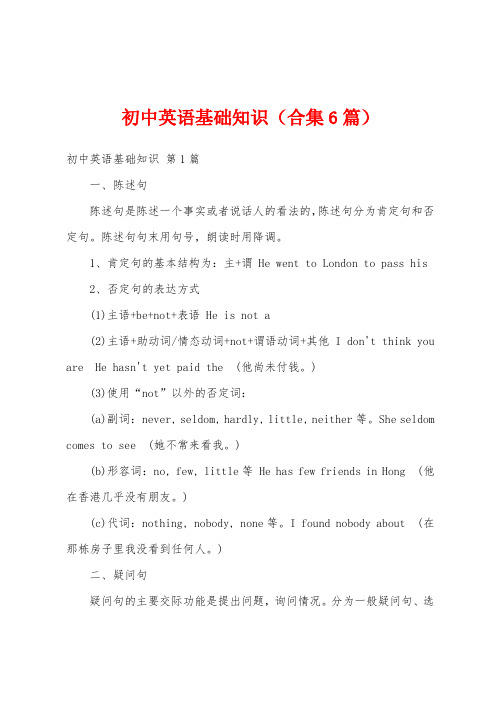
初中英语基础知识(合集6篇)初中英语基础知识第1篇一、陈述句陈述句是陈述一个事实或者说话人的看法的,陈述句分为肯定句和否定句。
陈述句句末用句号,朗读时用降调。
1、肯定句的基本结构为:主+谓 He went to London to pass his2、否定句的表达方式(1)主语+be+not+表语 He is not a(2)主语+助动词/情态动词+not+谓语动词+其他 I don't think you are He hasn't yet paid the (他尚未付钱。
)(3)使用“not”以外的否定词:(a)副词:never, seldom, hardly, little, neither等。
She seldom comes to see (她不常来看我。
)(b)形容词:no, few, little等 He has few friends in Hong (他在香港几乎没有朋友。
)(c)代词:nothing, nobody, none等。
I found nobody about (在那栋房子里我没看到任何人。
)二、疑问句疑问句的主要交际功能是提出问题,询问情况。
分为一般疑问句、选择疑问句、特殊疑问句和反意疑问句。
1、一般疑问句通常用来询问一件事情是否属实。
答句通常是“yes 或no”。
句型一:Be +主语+ …?Are these books on the desk?这些书在桌子上吗?句型二:Do / Does / Did + 主语 +谓语+…?Do you like English?你喜欢英语吗? 句型三:情态动词 + 主语 + 谓语 +…?Must I finish my homework now?我必须现在完成我的家庭作业吗?句型四:Have / Has + 主语 + 过去分词+…?Have you heard from him? 你收到他的来信吗?初中英语基础知识第2篇一、thanks / thank 因而感谢for是介词,后接n / pron / (名词/代词、动名词)Thanksfor the photo of your 谢谢你的全家福照片。
(超详)初中英语知识点归纳汇总
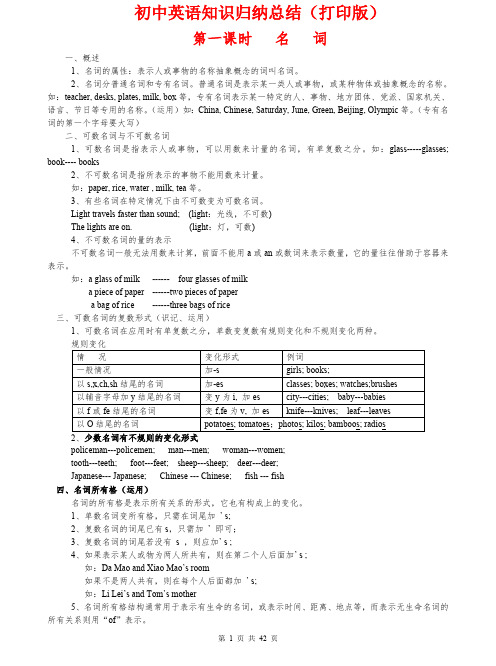
一种是不定冠词(the Indefinite Article). a an
三、不定冠词的用法
a 用于辅音音素起首的单词前,an 用于元音音素起首的单词前。
1、当第一次提到某人或某物时,用 a 或 an 起介绍作用,如:
What is this? It is a bus.
Who is she? She is a doctor.
4、如果表示某人或物为两人所共有,则在第二个人后面加’ s ;
如:Da Mao and Xiao Mao’s room
如果不是两人共有,则在每个人后面都加 ’ s;
如:Li Lei’s and Tom’s mother
5、名词所有格结构通常用于表示有生命的名词,或表示时间、距离、地点等,而表示无生命名词的
二、不用冠词的情况
1、除一些特殊情况外,专用名词以及抽象名词和物质名词前不加冠词。如:
Man is mortal.
Miss Smith came in power at last.
2、当名词前已有 this, that, my, his, any, every, some, no, those, these 等词修饰时或有所有格修饰时,
3、名词有定语修饰时,须用定冠词 the,表示特指意义。如:
The book on the desk is his.
The teacher who talked with you is her mother.
4、用于世界上独一无二的事物前。如:
the sun
the moon
the earth the sky
4、可用于某些词组,是该词组不可缺少的组成部分。如:
a long time
a little
初中英语知识点最全总结

初中英语知识点最全总结一、词汇与语法1. 词汇积累- 基础词汇:掌握与日常生活相关的基础词汇,如颜色、数字、食物、动物等。
- 主题词汇:根据课程内容,积累与学校生活、家庭、职业、交通等相关的主题词汇。
- 扩展词汇:通过阅读和听力练习,逐步扩展词汇量,包括形容词、副词、动词短语等。
2. 语法结构- 时态:掌握一般现在时、一般过去时、一般将来时等基本时态的构成和用法。
- 语态:了解被动语态的构成和用法。
- 非谓语动词:学习动名词、分词(现在分词和过去分词)的用法。
- 句型:熟悉简单句、并列句和复合句(包括定语从句、状语从句等)的结构和用法。
- 代词:正确使用人称代词、物主代词、反身代词、指示代词、疑问代词等。
- 冠词:掌握不定冠词(a/an)和定冠词(the)的用法。
- 介词:学习常用介词(如at, in, on, for, with等)的用法及其短语搭配。
- 连词:了解并列连词(and, but, or等)和从属连词(because, since, although等)的用法。
二、听力与口语1. 听力技巧- 预测:根据上下文预测对话或短文的内容。
- 捕捉关键信息:在听力材料中快速识别关键词汇和信息。
- 理解语境:通过语调和语气理解说话人的意图和情感。
2. 口语表达- 发音:练习正确的发音和语音语调。
- 情景对话:通过模拟日常情景进行对话练习。
- 描述和叙述:练习描述人物、地点、事件和叙述故事的能力。
- 演讲和陈述:培养清晰表达观点和进行简短演讲的能力。
三、阅读与写作1. 阅读理解- 快速阅读:通过快速阅读抓住文章的主旨大意。
- 细读理解:细致阅读,理解文章的具体细节和深层含义。
- 推理判断:根据文章内容进行逻辑推理和判断。
- 词汇理解:通过上下文猜测生词的意思。
2. 写作技巧- 句子构建:学习如何构建完整、正确的句子。
- 段落写作:掌握段落的结构,包括主题句和支持句。
- 文章组织:学习如何组织文章,使其有清晰的开头、中间和结尾。
初中英语基础知识点集
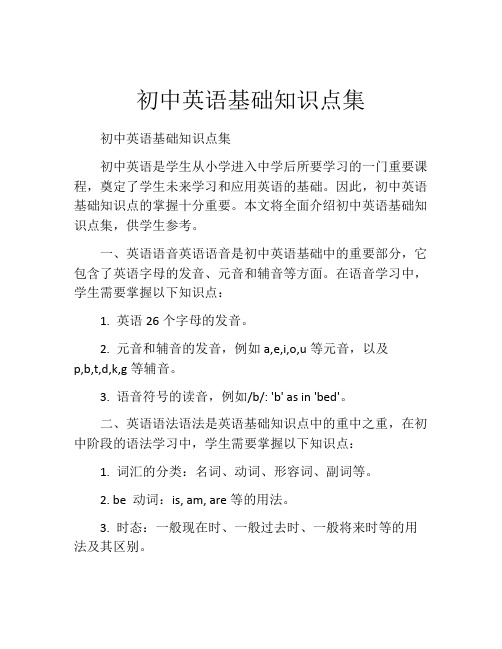
初中英语基础知识点集初中英语基础知识点集初中英语是学生从小学进入中学后所要学习的一门重要课程,奠定了学生未来学习和应用英语的基础。
因此,初中英语基础知识点的掌握十分重要。
本文将全面介绍初中英语基础知识点集,供学生参考。
一、英语语音英语语音是初中英语基础中的重要部分,它包含了英语字母的发音、元音和辅音等方面。
在语音学习中,学生需要掌握以下知识点:1. 英语26个字母的发音。
2. 元音和辅音的发音,例如a,e,i,o,u等元音,以及p,b,t,d,k,g等辅音。
3. 语音符号的读音,例如/b/: 'b' as in 'bed'。
二、英语语法语法是英语基础知识点中的重中之重,在初中阶段的语法学习中,学生需要掌握以下知识点:1. 词汇的分类:名词、动词、形容词、副词等。
2. be 动词:is, am, are等的用法。
3. 时态:一般现在时、一般过去时、一般将来时等的用法及其区别。
4. 动词的时态变化和构成:过去式、过去分词等的构成和用法。
5. 从句的语法结构:简单从句和复合从句的区别,还需要掌握一些常用的连词和副词,如because, if, when 等。
6. 形容词和副词:形容词和副词的用法、同义词的区别和一些常用的形容词和副词。
三、英语阅读阅读是学习英语的重要途径之一,也是初中阶段英语基础知识点中的重要环节,学生需要掌握以下知识点:1. 能够辨认主要人物、事件及文化背景。
2. 能够理解整段、整篇的论述或说明、比较、对比、因果关系、转折关系、递进顺序和类比等的语言形式和意义。
3. 能够理解语篇中的固定说法、隐喻和应用常识等。
四、英语写作写作能力是初中英语基础知识点中比较考验学生的一环,学生需要掌握以下知识点:1. 基本的写作格式和规范,如书信、口头介绍等。
2. 语法和拼写的正确性。
3. 能够运用一些句型,如一般疑问句、陈述句等。
4. 能够表达一个简单的意思、描述一个人、物或场景等。
初中英语知识点汇总

初中英语知识点汇总一、语法1.一般现在时:描述经常性、习惯性、普遍性的行为、事实、观点等2.一般过去时:表示过去一些时间发生的动作或存在的状态3.一般将来时:表示将要发生的动作或存在的状态4.现在进行时:表示正在进行的动作5.过去进行时:表示过去一些时间正在进行的动作6.将来进行时:表示将来一些时间正在进行的动作7.现在完成时:表示过去一些时间开始并一直延续到现在的动作或状态8.过去完成时:表示过去一些时间之前已经完成的动作或状态9.将来完成时:表示将来一些时间之前已经完成的动作或状态10.一般条件句:表示条件和结果之间的关系,包括真实条件句和虚拟条件句11.让步状语从句:表示与主句相反的情况12.终止状语从句:表示动作的结果或目的13.目的状语从句:表示为了达到一些目的14.表示时间的状语从句:表示动作发生的时间15.表示原因的状语从句:表示出发点或原因16.表示结果的状语从句:表示结果或后果17.表示条件的状语从句:表示条件18.表示方式或方式的状语从句:表示方式二、词汇1.名词:表示人、动物、植物、事物、地点等2.动词:表示人或事物的行为、状态、感受等3.形容词:表示人或事物的性质、特征、外貌等4.副词:修饰动词、形容词、副词,表示时间、地点、程度等5.代词:代替名词的词语6.冠词:限定名词的词语,分为定冠词和不定冠词7.数词:表示数量的词语,包括基数词和序数词8.介词:表示位置、方向、时间、原因等关系的词语9.连词:连接词语、短语、从句等的词语10.感叹词:表示情感或强调的词语三、阅读理解1.主旨概括:根据文章的标题、开头、结尾等写出文章的主要内容2.细节理解:根据文章中具体的信息回答问题3.词义理解:根据上下文推测词语的含义4.推理判断:根据文章的信息进行推理判断5.排序归纳:根据文章的内容将信息进行排序归纳6.补全信息:根据文章的信息填写所缺失的信息7.文章写作:根据提供的信息写一篇文章或段落四、语言表达1.情景对话:根据提供的情景进行对话练习2.议论文写作:根据提供的话题写一篇议论文3.书信写作:根据提供的写作要求写一封书信4.日记写作:根据提供的写作要求写一篇日记5.句子改写:根据提供的句子改写成不同形式的句子6.句子翻译:将提供的句子翻译成英语7.段落翻译:将提供的段落翻译成英语。
初中英语知识点大全总结
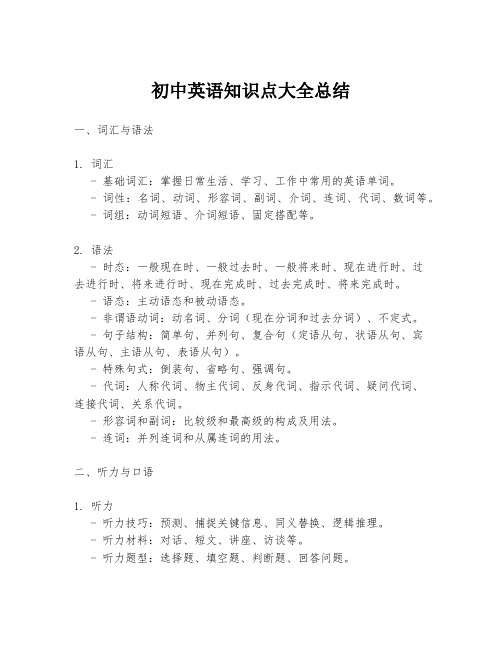
初中英语知识点大全总结一、词汇与语法1. 词汇- 基础词汇:掌握日常生活、学习、工作中常用的英语单词。
- 词性:名词、动词、形容词、副词、介词、连词、代词、数词等。
- 词组:动词短语、介词短语、固定搭配等。
2. 语法- 时态:一般现在时、一般过去时、一般将来时、现在进行时、过去进行时、将来进行时、现在完成时、过去完成时、将来完成时。
- 语态:主动语态和被动语态。
- 非谓语动词:动名词、分词(现在分词和过去分词)、不定式。
- 句子结构:简单句、并列句、复合句(定语从句、状语从句、宾语从句、主语从句、表语从句)。
- 特殊句式:倒装句、省略句、强调句。
- 代词:人称代词、物主代词、反身代词、指示代词、疑问代词、连接代词、关系代词。
- 形容词和副词:比较级和最高级的构成及用法。
- 连词:并列连词和从属连词的用法。
二、听力与口语1. 听力- 听力技巧:预测、捕捉关键信息、同义替换、逻辑推理。
- 听力材料:对话、短文、讲座、访谈等。
- 听力题型:选择题、填空题、判断题、回答问题。
2. 口语- 发音:元音、辅音、连读、失去爆破、语调、重音。
- 口语表达:日常交流、描述事物、表达意见、进行讨论。
- 口语题型:情景对话、图片描述、角色扮演、自由发言。
三、阅读与写作1. 阅读- 阅读技巧:快速阅读、精读、扫读、略读、寻找主旨大意、推断词义。
- 阅读材料:故事、科普文章、新闻报道、广告、说明文等。
- 阅读理解题型:选择题、判断题、填空题、回答问题。
2. 写作- 写作类型:记叙文、议论文、说明文、应用文(书信、日记、通知、报告)。
- 写作技巧:构思、组织结构、运用词汇和句型、连接词的使用、审题和修改。
- 写作格式:段落结构、标点符号、大小写、引用和参考文献。
四、英语文化与学习策略1. 英语文化- 节日习俗:圣诞节、感恩节、万圣节等。
- 历史地理:主要英语国家的历史和文化、地理位置。
- 文学艺术:著名英语作家和作品、音乐、电影等。
初中英语基础知识大全中考必备
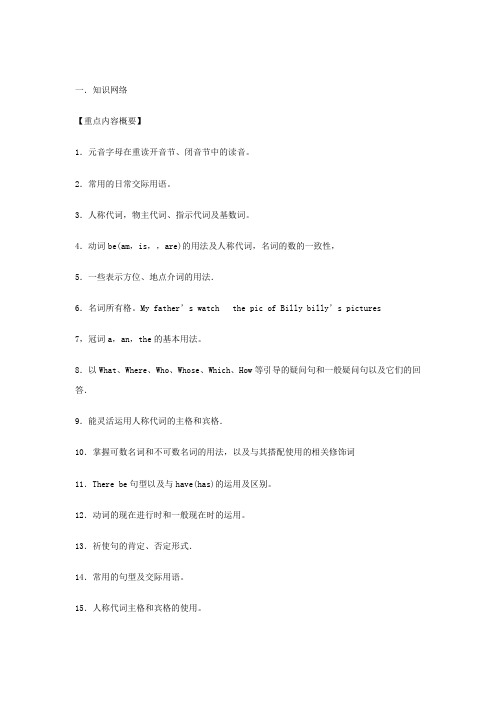
一.知识网络【重点内容概要】1.元音字母在重读开音节、闭音节中的读音。
2.常用的日常交际用语。
3.人称代词,物主代词、指示代词及基数词。
4.动词be(am,is,,are)的用法及人称代词,名词的数的一致性,5.一些表示方位、地点介词的用法.6.名词所有格。
My father’s watch the pic of Billy billy’s pictures7,冠词a,an,the的基本用法。
8.以What、Where、Who、Whose、Which、How等引导的疑问句和一般疑问句以及它们的回答.9.能灵活运用人称代词的主格和宾格.10.掌握可数名词和不可数名词的用法,以及与其搭配使用的相关修饰词11.There be句型以及与have(has)的运用及区别。
12.动词的现在进行时和一般现在时的运用。
13.祈使句的肯定、否定形式.14.常用的句型及交际用语。
15.人称代词主格和宾格的使用。
16.可数名词和不可数名词的运用.17.常用的句型。
18.现在进行时和一般现在时的使用。
【句型、词组精讲】Words and Expressions1. Excus e, me. / I’m sorry.这两个句子是会话时常用客套语。
1)Excuse me. 表示“劳驾”,“请问”,“请原谅”,“对不起”,“打扰一下”等意思,多用于句首,主要用于在请求别人帮忙时用。
如:Excuse me, is this watch yours?Excuse me. How can I get to the station?2)I’m sorry. 或Sorry. 一般用于听到别人的不幸或做了对不起别人的事情表示遗憾或向其道歉,或不能够给对方提供信息或帮助时的场合。
如:I’m sorry I’m late.I’m sorry to hear your mother is ill.Sorry, I can’t go with you.Sorry, I won’t do that again.2. it’s / its1)it’s是it is的缩写形式,意思是“那是”。
初中英语知识点总结大全集
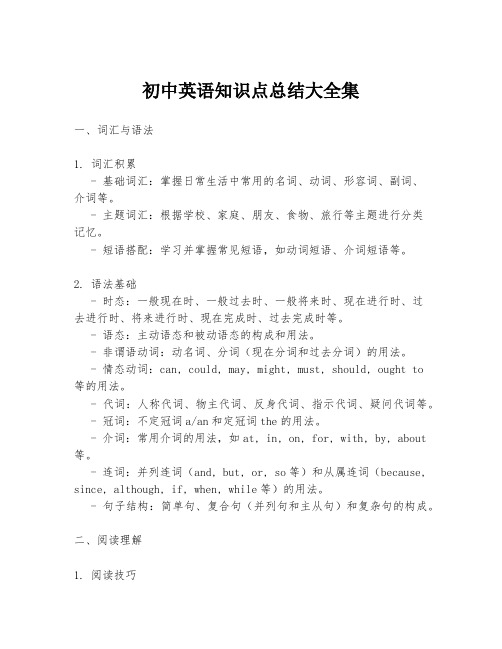
初中英语知识点总结大全集一、词汇与语法1. 词汇积累- 基础词汇:掌握日常生活中常用的名词、动词、形容词、副词、介词等。
- 主题词汇:根据学校、家庭、朋友、食物、旅行等主题进行分类记忆。
- 短语搭配:学习并掌握常见短语,如动词短语、介词短语等。
2. 语法基础- 时态:一般现在时、一般过去时、一般将来时、现在进行时、过去进行时、将来进行时、现在完成时、过去完成时等。
- 语态:主动语态和被动语态的构成和用法。
- 非谓语动词:动名词、分词(现在分词和过去分词)的用法。
- 情态动词:can, could, may, might, must, should, ought to等的用法。
- 代词:人称代词、物主代词、反身代词、指示代词、疑问代词等。
- 冠词:不定冠词a/an和定冠词the的用法。
- 介词:常用介词的用法,如at, in, on, for, with, by, about 等。
- 连词:并列连词(and, but, or, so等)和从属连词(because, since, although, if, when, while等)的用法。
- 句子结构:简单句、复合句(并列句和主从句)和复杂句的构成。
二、阅读理解1. 阅读技巧- 快速阅读:通过略读(skimming)和扫读(scanning)快速获取文章大意。
- 精读:深入理解文章内容,分析文章结构和作者意图。
- 推理判断:根据上下文推断生词含义,理解隐含信息。
2. 阅读题型- 事实细节题:找出文章中的具体信息。
- 主旨大意题:确定文章的主题或中心思想。
- 推理判断题:根据文章内容进行逻辑推理。
- 词义猜测题:猜测生词或短语的含义。
- 作者态度题:判断作者对于某一观点或事物的态度。
三、写作技巧1. 写作结构- 引言:开篇引入话题,提出观点或问题。
- 正文:分段阐述观点,提供支持细节或例证。
- 结尾:总结全文,重申观点或提出建议。
2. 写作类型- 描述性写作:描述人物、地点、事件或物品。
初中英语基础知识(知识点)合集

初中英语语法大全语法网络图一.名词I.名词的种类:II. 名词的数:1. 规则名词的复数形式:名词的复数形式,一般在单数形式后面加-s或-es。
现将构成方法与读音规则列表如下:2. 不规则名词复数:英语里有些名词的复数形式是不规则的,现归纳如下:III. 名词的所有格:名词在句中表示所有关系的语法形式叫做名词所有格。
所有格分两种:一是名词词尾加’s 构成,二是由介词of加名词构成。
前者多表示有生命的东西,后者多表示无生命的东西。
1. ’s所有格的构成:2. ’s所有格的用法:3. of所有格的用法:用于无生命的东西:the legs of the chair, the cover of the book用于有生命的东西,尤其是有较长定语时:the classrooms of the first-year students 用于名词化的词:the struggle of the oppressed二.冠词冠词分为不定冠词(a, an),定冠词(the),和零冠词。
I.不定冠词的用法:II. 定冠词的用法:III. 零冠词的用法:三.代词:I.代词可以分为以下七大类:II. 不定代词用法注意点:1. one, some与any:1) one可以泛指任何人,也可特指,复数为ones。
some多用于肯定句,any多用于疑问句和否定句。
One should learn to think of others.Have you any bookmarks? No, I don’t have any bookmarks.I have some questions to ask.2) some可用于疑问句中,表示盼望得到肯定的答复,或者表示建议,请求等。
Would you like some bananas?Could you give me some money?3) some 和any修饰可数名词单数时,some表示某个,any表示任何一个。
初中英语知识点总结大纲

初中英语知识点总结大纲一、词汇学习1. 基础词汇积累- 常见名词、动词、形容词、副词- 常用短语和句型- 同义词、反义词及其辨析2. 词性转换- 名词的单复数形式- 动词的时态变化- 形容词和副词的比较级和最高级形式- 规则与不规则变化的规律3. 词组搭配- 动词短语- 介词短语- 形容词与名词的搭配- 常见情景对话中的实用表达二、语法知识1. 时态- 一般现在时- 一般过去时- 一般将来时- 现在进行时- 过去进行时- 将来进行时- 现在完成时- 过去完成时- 将来完成时2. 语态- 被动语态的构成和用法- 主动语态与被动语态的转换3. 非谓语动词- 动名词的用法- 分词(现在分词和过去分词)的用法- 不定式的用法4. 句子结构- 简单句的构成- 并列句的连接词使用- 复合句的分类与构成(名词性从句、定语从句、状语从句) - 句子成分分析(主语、谓语、宾语、定语、状语等)5. 特殊句式- 倒装句- 省略句- 强调句6. 代词- 人称代词、物主代词、反身代词- 指示代词、疑问代词、不定代词三、阅读理解1. 阅读技巧- 快速阅读与寻找关键信息- 推理判断与细节理解- 作者意图与文章大意2. 题型分析- 选择题- 判断题- 填空题- 回答问题3. 常见题型解题策略- 事实细节题- 主旨大意题- 推理判断题- 词义猜测题四、写作技巧1. 写作基本要素- 词汇的准确使用- 句子结构的多样性- 段落结构的逻辑性2. 写作类型- 记叙文- 议论文- 说明文- 应用文(书信、日记、通知等)3. 写作步骤- 构思与提纲- 草拟初稿- 修改与润色4. 常见写作问题及对策 - 语法错误- 词汇贫乏- 逻辑不清五、听力训练1. 听力技巧- 预测与猜测- 捕捉关键信息- 培养同义替换意识2. 听力材料类型- 对话- 短文- 讲座与访谈3. 听力题型- 选择题- 填空题- 判断题4. 听力策略- 听力前的准备- 听力中的笔记- 听力后的检查六、口语表达1. 发音规则- 音标学习- 元音与辅音的发音 - 连读、弱读、重音2. 口语功能- 问候与自我介绍- 询问与提供信息- 表达意见与情感3. 口语话题- 日常生活- 学校生活- 旅行与文化4. 口语练习方法- 角色扮演- 情景对话- 讨论与演讲七、英语文化与习俗1. 节日与庆典- 圣诞节、感恩节等西方节日 - 节日习俗与活动2. 英语国家地理与历史- 主要英语国家地理位置- 历史事件与文化背景3. 英语习语与俚语- 常见习语的意义与用法- 俚语的理解与应用4. 文化差异与交流- 中西方文化差异- 跨文化交流技巧八、学习策略与习惯1. 学习方法- 制定学习计划 - 分阶段学习目标。
初中英语总复习知识点归纳(基本全了)
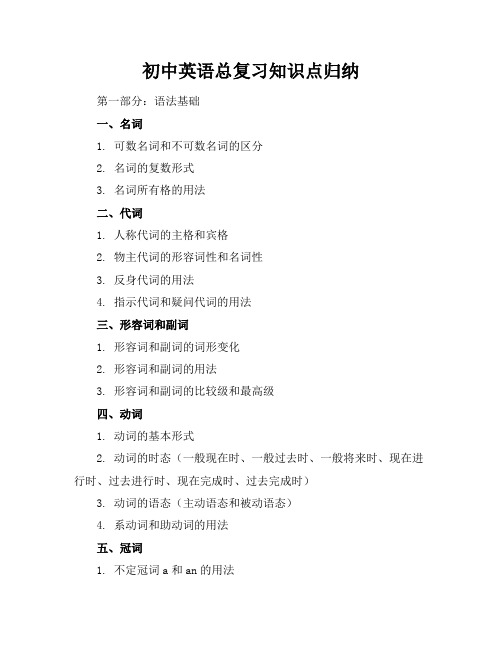
初中英语总复习知识点归纳第一部分:语法基础一、名词1. 可数名词和不可数名词的区分2. 名词的复数形式3. 名词所有格的用法二、代词1. 人称代词的主格和宾格2. 物主代词的形容词性和名词性3. 反身代词的用法4. 指示代词和疑问代词的用法三、形容词和副词1. 形容词和副词的词形变化2. 形容词和副词的用法3. 形容词和副词的比较级和最高级四、动词1. 动词的基本形式2. 动词的时态(一般现在时、一般过去时、一般将来时、现在进行时、过去进行时、现在完成时、过去完成时)3. 动词的语态(主动语态和被动语态)4. 系动词和助动词的用法五、冠词1. 不定冠词a和an的用法2. 定冠词the的用法3. 不使用冠词的情况六、连词1. 并列连词的用法2. 从属连词的用法七、介词1. 常用介词的用法2. 介词短语的结构和用法八、数词1. 基数词和序数词的用法2. 分数、小数和百分数的表达九、感叹词1. 感叹词的用法十、疑问词1. 疑问词的用法十一、句型结构1. 简单句的五种基本句型2. 并列句和复合句的结构和用法十二、主谓一致1. 主谓一致的原则2. 主谓一致的特殊情况十三、倒装句1. 完全倒装和部分倒装的区别2. 常见的倒装句型十四、省略句1. 省略句的结构和用法十五、强调句1. 强调句的结构和用法十六、虚拟语气1. 虚拟语气的用法十七、情态动词1. 情态动词的用法十八、非谓语动词1. 非谓语动词的分类和用法十九、固定搭配1. 常见的固定搭配二十、习惯用语和俚语1. 常见的习惯用语和俚语第二部分:词汇与短语一、词汇记忆方法1. 词根词缀记忆法2. 同义词和反义词记忆法3. 分类记忆法4. 联想记忆法二、常见词汇和短语1. 常用动词短语2. 常用形容词短语3. 常用介词短语4. 常用连词短语5. 常用固定搭配三、词汇辨析1. 形近词辨析2. 意思相近的词辨析3. 语境辨析四、词汇应用1. 词汇在句子中的应用2. 词汇在段落中的应用3. 词汇在文章中的应用五、词汇扩展1. 通过阅读扩展词汇2. 通过听力扩展词汇3. 通过口语和写作扩展词汇六、词汇复习策略1. 制定词汇复习计划2. 定期进行词汇测试3. 反复记忆和复习第三部分:阅读理解一、阅读技巧1. 快速阅读2. 精读3. 猜词技巧4. 理解文章主旨和大意5. 找出文章中的细节信息二、阅读题型1. 主旨大意题2. 细节理解题3. 推理判断题4. 词义猜测题5. 观点态度题三、阅读材料1. 故事类文章2. 议论文3. 说明文4. 应用文5. 新闻报道四、阅读理解策略1. 预览文章和首段2. 扫读文章找出关键词3. 仔细阅读理解文章内容4. 回答问题时注意关键词和语境5. 验证答案是否符合文章内容第四部分:写作技能一、写作技巧1. 确定写作目的和主题2. 拟定写作提纲3. 运用适当的句型和词汇4. 保持文章逻辑清晰5. 注意文章格式和标点符号二、写作题型1. 记叙文2. 议论文3. 说明文4. 应用文5. 日记和书信三、写作素材1. 人物描写2. 地点描写3. 事件描写4. 情感表达5. 观点陈述四、写作策略1. 多读优秀范文2. 多练习写作3. 请教老师和同学4. 反复修改和润色5. 保持写作兴趣和热情第五部分:听力理解一、听力技巧1. 预测听力内容2. 抓住关键词和关键信息4. 边听边记笔记5. 理解对话和独白的逻辑关系二、听力题型1. 简单听力理解题2. 听力细节理解题3. 听力推理判断题4. 听力主旨大意题5. 听力词义猜测题三、听力材料1. 对话2. 独白3. 新闻报道4. 广播节目5. 电影和电视剧片段四、听力理解策略1. 预览问题和选项2. 仔细听录音,注意关键词3. 根据听力内容进行推理和判断4. 选择最符合听力内容的答案5. 检查答案是否符合题意第六部分:口语表达一、口语技巧1. 准备话题和内容3. 保持语速适中4. 注意语法和词汇的准确性5. 保持自信和流畅二、口语题型1. 自我介绍2. 话题讨论3. 角色扮演4. 观点陈述5. 回答问题三、口语素材1. 日常生活话题2. 学校生活话题3. 社会热点话题4. 个人兴趣爱好话题5. 旅游和文化话题四、口语表达策略1. 多听多说,提高口语能力2. 模仿优秀的口语表达3. 与老师和同学进行口语练习4. 参加英语角和口语比赛5. 记录自己的口语表达,进行反思和改进第七部分:综合技能一、综合技巧1. 综合运用语法、词汇、阅读、写作、听力和口语等技能2. 注重语言的实际运用能力3. 提高语言的综合运用水平4. 培养跨文化交际能力5. 保持学习英语的兴趣和动力二、综合题型1. 完形填空2. 阅读理解3. 写作4. 听力理解5. 口语表达三、综合复习策略1. 制定综合复习计划2. 定期进行综合测试3. 反复练习和复习4. 请教老师和同学5. 保持学习英语的兴趣和热情。
初中英语基础知识点集

初中英语基础知识点集初中英语基础知识点集英语作为一门全球通用的语言,在各级教育中占有重要地位。
因此,初中英语基础知识点学习就显得非常重要。
下面我们就来一起梳理、总结一下初中英语基础知识点集。
1. 名词名词是指人、事物、地方、抽象概念等,它是英语语法中最基础、最重要的一部分。
名词分为可数名词和不可数名词,可数名词具有单复数形式,而不可数名词只有单数形式。
另外,英语还有专有名词,指特定的人或地方,例如中国、纽约等。
2. 代词代词在语言中是指代所指人或事物的一种词语,它可以作主、宾、定语或表语。
代词也可以分为人称代词、物主代词、指示代词、疑问代词、不定代词等。
3. 冠词冠词是名词前面的限定词,常见的有定冠词“the”和不定冠词“a/an”。
定冠词用来指定某一个特定的人或物,不定冠词用来泛指某一类人或物。
4. 动词动词是英语语法中的主要部分,可以表示一个动作、状态或情感等。
动词根据不同的时态、语态、情态等因素有不同的变化。
例如,时态包括现在时、过去时、将来时等;语态包括主动语态、被动语态等;情态包括可以、必须等。
5. 形容词和副词形容词是用来描述名词的词语。
它们可以表示物品的颜色、大小、形状、数量、感觉等等,也可以表示人的性格、情感或外貌等。
副词用来描述动词、形容词或其他副词的词语,用来修饰动作的方式、程度等等。
6. 介词和介词短语介词是一种连接词,用来连接名词、代词或词组,来表达它们之间的关系。
例如,“in”、“on”、“at”、“to”等都是常见的介词。
介词短语是由介词和它的宾语构成。
7. 连词连词是一种连接词的词语,用来连接单词、短语、句子等等,来构成复合句。
连词分为从属连词和并列连词两种。
从属连词用来连接主句和从句,常见的从属连词有“when”、“because”、“although”等;并列连词用来连接两个或多个并列的单词、短语或句子,常见的并列连词有“and”、“or”、“but”等。
8. 数词数词是用来表示数量的词语,可以分为基数词和序数词。
初中英语必考知识点总结
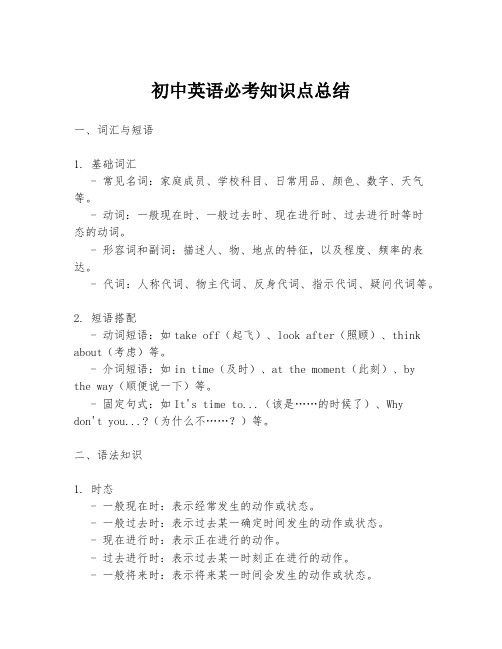
初中英语必考知识点总结一、词汇与短语1. 基础词汇- 常见名词:家庭成员、学校科目、日常用品、颜色、数字、天气等。
- 动词:一般现在时、一般过去时、现在进行时、过去进行时等时态的动词。
- 形容词和副词:描述人、物、地点的特征,以及程度、频率的表达。
- 代词:人称代词、物主代词、反身代词、指示代词、疑问代词等。
2. 短语搭配- 动词短语:如take off(起飞)、look after(照顾)、think about(考虑)等。
- 介词短语:如in time(及时)、at the moment(此刻)、by the way(顺便说一下)等。
- 固定句式:如It's time to...(该是……的时候了)、Whydon't you...?(为什么不……?)等。
二、语法知识1. 时态- 一般现在时:表示经常发生的动作或状态。
- 一般过去时:表示过去某一确定时间发生的动作或状态。
- 现在进行时:表示正在进行的动作。
- 过去进行时:表示过去某一时刻正在进行的动作。
- 一般将来时:表示将来某一时间会发生的动作或状态。
2. 语态- 被动语态:表示动作的承受者成为句子的主语。
- 常见时态的被动语态形式。
3. 非谓语动词- 动名词:作为名词使用,可以作主语、宾语等。
- 分词:现在分词和过去分词,用作形容词或副词。
- 不定式:作为名词、形容词、副词等使用。
4. 句子结构- 简单句:只有一个主语和谓语的句子。
- 并列句:由两个或多个简单句通过并列连词连接而成。
- 复合句:包含主句和从句的句子,从句可以是名词性从句、定语从句或状语从句。
5. 特殊句式- 倒装句:在某些特定条件下,句子的主语和谓语可以颠倒。
- 省略句:在某些情况下,句子中的某些成分可以省略。
三、阅读理解1. 快速阅读- 通过扫读(Skimming)和查读(Scanning)快速获取文章大意和细节信息。
2. 细节理解- 理解文章中具体的事实和细节,包括数字、时间、地点等。
初中英语基础知识(知识点)合集
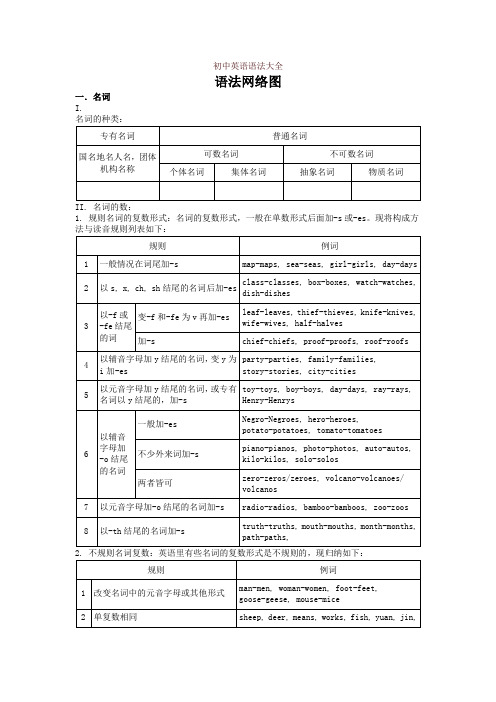
初中英语语法大全语法网络图一.名词I.名词的种类:II. 名词的数:1. 规则名词的复数形式:名词的复数形式,一般在单数形式后面加-s或-es。
现将构成方法与读音规则列表如下:2. 不规则名词复数:英语里有些名词的复数形式是不规则的,现归纳如下:III. 名词的所有格:名词在句中表示所有关系的语法形式叫做名词所有格。
所有格分两种:一是名词词尾加’s 构成,二是由介词of加名词构成。
前者多表示有生命的东西,后者多表示无生命的东西。
1. ’s所有格的构成:2. ’s所有格的用法:3. of所有格的用法:用于无生命的东西:the legs of the chair, the cover of the book用于有生命的东西,尤其是有较长定语时:the classrooms of the first-year students 用于名词化的词:the struggle of the oppressed二.冠词冠词分为不定冠词(a, an),定冠词(the),和零冠词。
I.不定冠词的用法:II. 定冠词的用法:III. 零冠词的用法:三.代词:I.II. 不定代词用法注意点:1. one, some与any:1) one可以泛指任何人,也可特指,复数为ones。
some多用于肯定句,any多用于疑问句和否定句。
One should learn to think of others.Have you any bookmarks? No, I don’t have any bookmarks.I have some questions to ask.2) some可用于疑问句中,表示盼望得到肯定的答复,或者表示建议,请求等。
Would you like some bananas?Could you give me some money?3) some 和any修饰可数名词单数时,some表示某个,any表示任何一个。
- 1、下载文档前请自行甄别文档内容的完整性,平台不提供额外的编辑、内容补充、找答案等附加服务。
- 2、"仅部分预览"的文档,不可在线预览部分如存在完整性等问题,可反馈申请退款(可完整预览的文档不适用该条件!)。
- 3、如文档侵犯您的权益,请联系客服反馈,我们会尽快为您处理(人工客服工作时间:9:00-18:30)。
初中英语语法大全语法网络图一.名词I.1. 规则名词的复数形式:名词的复数形式,一般在单数形式后面加-s或-es。
现将构成方法与读音规则列表如下:名词在句中表示所有关系的语法形式叫做名词所有格。
所有格分两种:一是名词词尾加’s 构成,二是由介词of加名词构成。
前者多表示有生命的东西,后者多表示无生命的东西。
用于无生命的东西:the legs of the chair, the cover of the book用于有生命的东西,尤其是有较长定语时:the classrooms of the first-year students 用于名词化的词:the struggle of the oppressed二.冠词冠词分为不定冠词(a, an),定冠词(the),和零冠词。
I.I.1. one, some与any:1) one可以泛指任何人,也可特指,复数为ones。
some多用于肯定句,any多用于疑问句和否定句。
One should learn to think of others.Have you any bookmarks No, I don’t have any bookmarks.I have some questions to ask.2) some可用于疑问句中,表示盼望得到肯定的答复,或者表示建议,请求等。
Would you like some bananas?Could you give me some money?3) some 和any修饰可数名词单数时,some表示某个,any表示任何一个。
I have read this article in some magazine.Please correct the mistakes, if any.4) some和数词连用表示“大约”,any可与比较级连用表示程度。
There are some 3,000 students in this school.Do you feel any better today?2. each和every:each强调个别,代表的数可以是两个或两个以上,而every强调整体,所指的数必须是三个或三个以上。
Each student has a pocket dictionary. / Each (of us) has a dictionary. / We each have a dictionary.Every student has strong and weak points. / Every one of us has strong and weak points.3. none和no:no等于not any,作定语。
none作主语或宾语,代替不可数名词,谓语用单数,代替可数名词,谓语单复数皆可以。
There is no water in the bottle.How much water is there in the bottle None.None of the students are (is) afraid of difficulties.4. other和another:1) other泛指“另外的,别的”常与其他词连用,如:the other day, every other week, some other reason, no other way,the other特指两者中的另外一个,复数为the others。
如:He held a book in one hand and his notes in the other.Two students in our class failed, but all the others passed the exam.2) another指“又一个,另一个”无所指,复数形式是others,泛指“别的人或事”如:I don’t like this s hirt, please show me another (one).The trousers are too long, please give me another pair / some others.Some like football, while others like basketball.5. all和both, neither和eitherall表示不可数名词时,其谓语动词用单数。
both和all加否定词表示部分否定,全部否定用neither和none.All of the books are not written in English. / Not all of the books are written in English.Both of us are not teachers. / Not both of us are teachers. / Either of us is a teacher.四.形容词和副词I.形容词:1. 形容词的位置:1) 形容词作定语通常前置,但在下列情况后置:形容词和副词的比较等级分为原级,比较级和最高级。
比较级和最高级的构成一般是在形容词和副词后加-er和-est,多音节和一些双音节词前加more 和most。
1. 同级比较时常常用as…as…以及not so(as)…as…如:I am not so good a player as you are.2. 可以修饰比较级的词有:much, many, a lot, even, far, a bit, a little, still, yet, by far, any, a great deal。
3. 表示一方随另一方变化时用“the more…the more…”句型。
如:The harder you work, the more progress you will make.4. 用比较级来表达最高级的意思。
如:I have never spent a more worrying day.5. 表示倍数的比较级有如下几种句型:Our school is three times larger than yours./Our school is four times as large as yours./Our school is four times the size of yours.6. 表示“最高程度“的形容词没有最高级和比较级。
如:favourite, excellent, extreme, perfect。
五.介词I.六.动词I.动词的时态:1. 动词的时态一共有16种,以ask为例,将其各种时态的构成形式列表如下:1) 现在完成时表示过去发生的动作或存在的状况,但和现在有联系,强调的是对现在造成的影响或结果,它不能同表示过去的时间状语连用,汉译英时可加“已经”等词。
简言之,利用过去,说明现在。
如:I have already read the novel written by the world-famous writer. (已经看过,且了解这本书的内容)2) 一般过去时只表示过去发生的动作或状态,和现在无关,它可和表示过去的时间状语连用,汉译英时可加“过”,“了”等词。
简言之,仅谈过去,不关现在。
如:I read the novel last month. (只说明上个月看了,不涉及现在是否记住)I lived in Beijing for ten years.(只说明在北京住过十年,与现在无关)3. 现在完成时与现在完成进行时的区别:两者都可以表示“从过去开始一直持续到现在”,在含义上如着重表示动作的结果时,多用现在完成时,如着重表示动作一直在进行,即动作的延续性时,则多用现在完成进行时。
一般不能用于进行时的动词也不能用于现在完成进行时。
I have read that book.我读过那本书了。
I have been reading that book all the morning. 我早上一直在读那本书。
七.情态动词I.以must为例。
must + do(be)是推测现在存在的一般状态进行;must + be doing 推测可能正在进行的事情;must +have done是推测可能已经发生过的事情。
1. must“肯定,一定”语气强,只用于肯定句中。
He must be a man from America. / He must be talking with his friend. / He must have already arrived there.2. may和might“也许”,后者语气弱,更没有把握。
可用于肯定句和否定句。
He may not be at home. / They might have finished their task.3. can和could“可能”,could表示可疑的可能性,不及can’t语气强,用于肯定、否定、疑问句中。
The weather in that city could be cold now.We could have walked there; it was so near.(推测某事本来可能发生,但实际上没有发生)Can he be in the office now No, he can’t be there, for I saw him in the library just now.(语气很强,常用于疑问句和否定句中)III. 情态动词注意点:1. can和be able to: 都可以表示能力。
但be able to可以表达“某事终于成功”,而can无法表达此意。
Be able to有更多的时态。
另外,两者不能重叠使用。
2. used to和would:used to表示过去常常做现在已经不再有的习惯,而would只表示过去的习惯或喜好,不涉及现在。
3. need和dare作情态动词和实义动词的区别:两者作情态动词时常用于否定句和疑问句。
其形式为:need n’t/daren’t do;Need/dare…do…?做实义动词时可用于肯定句,否定句和疑问句。
其形式为:need(needs/needed)/dare(dares/dared) to do, don’t(doesn’t/didn’t) need/dare to do八.非谓语动词I.非谓语动词的分类、意义及构成:九.定语从句I.定语从句起了形容词的作用,在句中修饰一个名词或代词。
被修饰的词叫做先行词,引导定语从句的词叫关系词,他的作用一是放在先行词与定语从句中间起了连接作用,二是在十.名词性从句十四。
